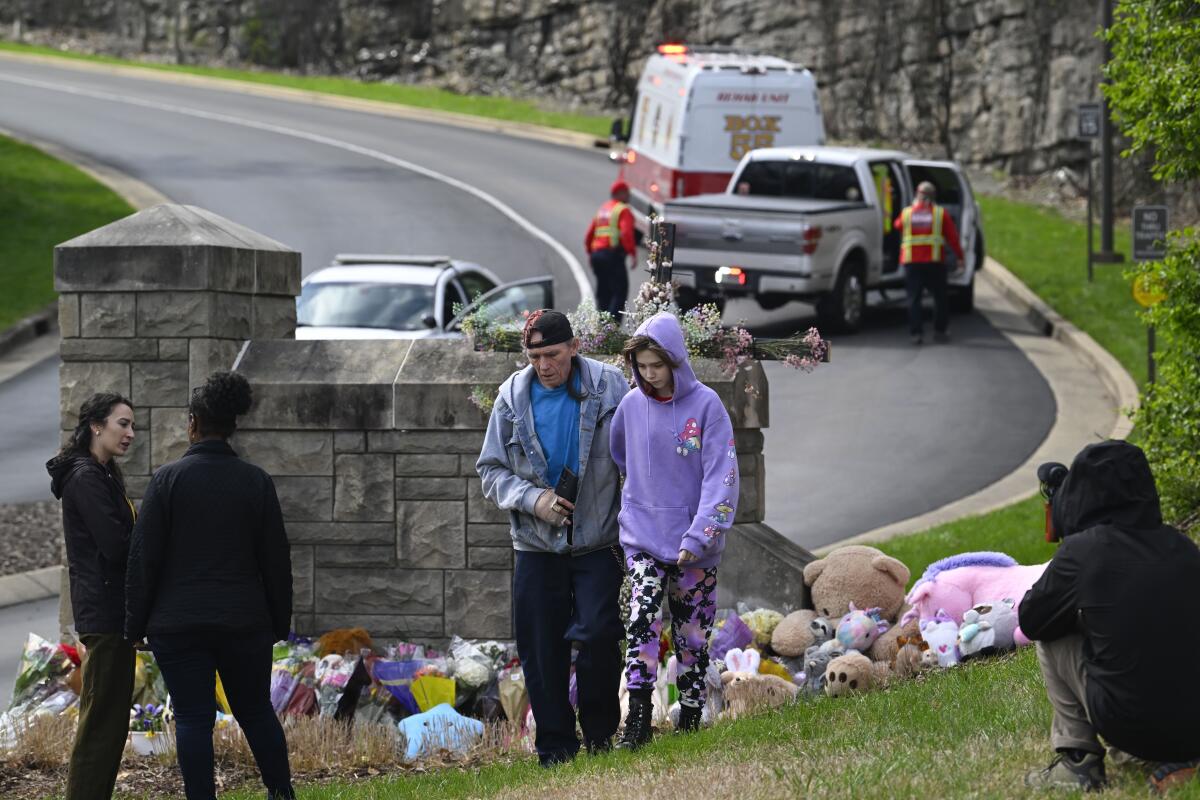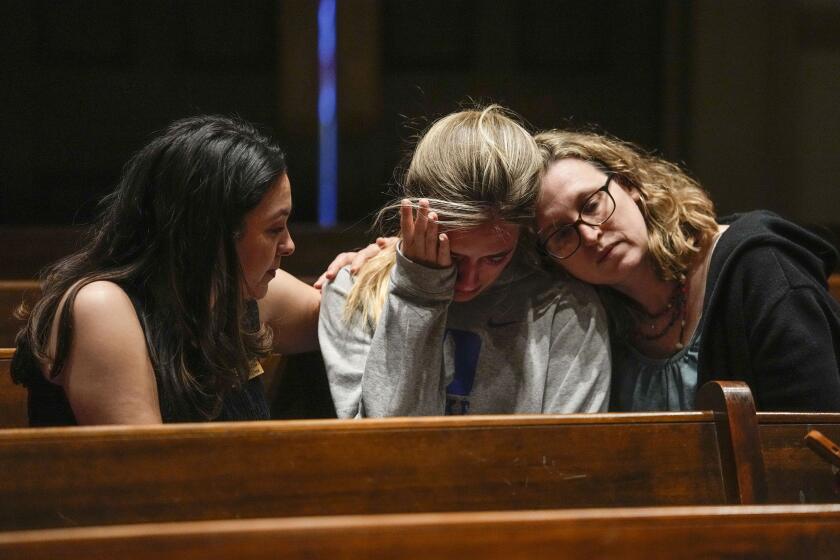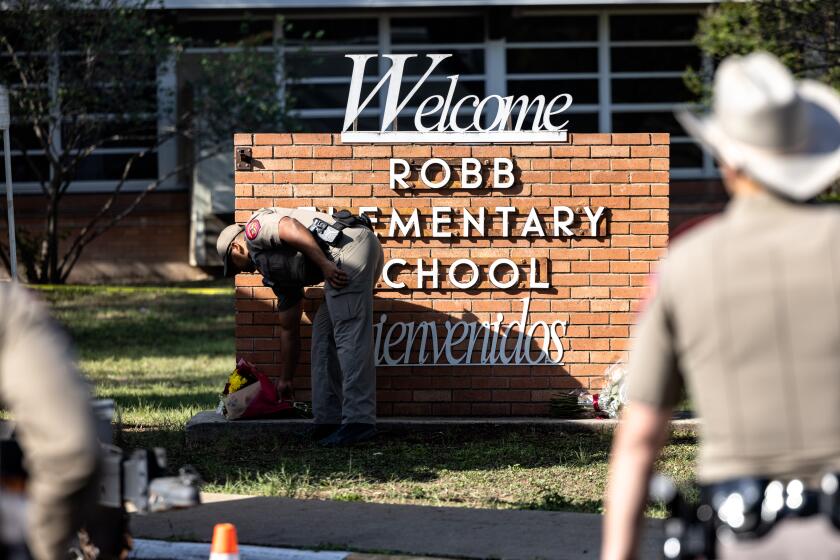Opinion: Will the Nashville shooting inspire action? Past waves of American violence did

- Share via
The murders of three children and three staff members at a school in Nashville on Monday was at least the 129th mass shooting of 2023. That’s a rate of 1.5 mass shootings, involving four or more victims, each day of the year.
The constant barrage can sow feelings of hopelessness in the majority of us who would rather not have a country where there are more guns than people and where gun violence is now the leading cause of death in children.
Hopelessness is precisely what manufacturers of those weapons and lobbyists in the NRA want: that we give up and give in, quietly consenting to the vile dogma that periodic bloodbaths are just another “price of freedom.”
To grow up counting victims of gun violence is not “freedom.” When will we decide that this isn’t how we want to live?
The first step in avoiding such resignation is to realize that we are living through an unusual surge in interpersonal violence, not an unbroken “normal” that stretches back to 1776.
To be sure, we’ve had other bloody peaks in our history. One began soon after the Revolution, when high-strung gentlemen aped European aristocrats by settling their disputes on the dueling ground. Among them was the shifty Aaron Burr, who is rightly excluded from the pantheon of Founders for having fatally shot Alexander Hamilton in 1804.
But that killing set off a widespread effort by clergy and moral reformers to stop and stigmatize dueling as illegal and un-Christian. Local and state governments followed with a long wave of gun control measures, including a ban on concealed weapons in Louisiana in 1813 and the careful regulation of gunpowder by Texas in 1839.
As the governor of New York noted in 1820, reckless people who carried concealed weapons violated the “essential right of every free citizen” to live in lawful safety.
Another surge in bloodshed came during Prohibition and the Depression. While common thugs such as Al Capone built empires out of smuggled booze and drive-by shootings, psychopaths such as Bonnie Parker and Clyde Barrow used Tommy guns to rob, pillage and kill.
“Here is Samuel Davino, only five years old, pointing to where he was shot in the leg,” relayed a 1931 newsreel after a gangland shooting in New York. “But poor little Samuel is more fortunate than Michael Vengali, also five. Michael met death. And this casket will hold his tiny body, broken by machine gun bullets.”
Here again, the people pushed back. In 1934, Congress enlisted the support of police, civic leaders and even the NRA to place a prohibitive tax on automatic weapons and short-barrel shotguns, while federal agencies took down gangsters and assassins by law where possible and force when necessary.
In other words, past surges in violence called forth multi-pronged, common-sense movements to address the bloodshed and restore peace. This is what we need now.
First, Congress must act again. Its 1994 assault ban worked, although how much is disputed. Something similar would work again, especially with greater funding for the agencies that enforce the laws.
In passing and renewing such laws, political leaders must not be dragged into abstruse arguments over whether the 2nd Amendment actually authorizes an individual right to pack heat — even though it says no such thing — or whether the patriots of 1776 would oppose gun controls, even though they were in the middle of a war and we are not. Just focus on the people’s right to be alive, rather than to be killed.
So many children are dying in school shootings because the U.S. doesn’t focus on prevention. There are ways we can stop these horrific massacres.
On that note, those who traffic deadly weapons can be held accountable in court for the bloodshed their products cause. A so-called public nuisance suit targeting a gun distributor helped reduce gun violence in Chicago; New York recently paved the way for more of these suits. (I’m on the Advisory Committee of Global Action on Gun Violence, which promotes such efforts.)
Finally, we need to rethink the leading role of violence in American culture. Put simply, we tell too many stories, whether in art, film or literature, that culminate in deadly force and retribution. Time and again, the choreographed tension in our most popular narratives explodes in visually stunning gore — as promised by “John Wick 4,” the movie that led the box office last weekend.
The belief that violence resolves and purifies has deep roots in particular strands of American Christianity, which in turn shape our national self-concept. To counter this, we need discussion across our many divides — listening to both secular and pious arguments — to rediscover the peaceful dimensions of our political, religious and moral traditions.
As the past tells us, confronting gun violence in a multifaceted way is more effective than pinning all our hopes on one law or another. It’s also more sustainable, both in terms of strategy and morale. When we fall short in Congress or a state legislature, we may win a class-action suit, or forge a new partnership between a church and a youth group.
No matter what happens, we must remember that gun violence is a historical phenomenon, not a manifest destiny, and that history ultimately bends to those who do not despair.
Jason Opal is an American professor of history at McGill University in Montreal.
More to Read
A cure for the common opinion
Get thought-provoking perspectives with our weekly newsletter.
You may occasionally receive promotional content from the Los Angeles Times.












